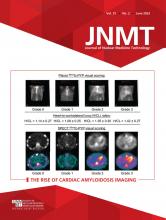Abstract
Cardiac amyloidosis was thought to be rare, undiagnosable, and incurable. However, recently it has been discovered to be common, diagnosable, and treatable. This knowledge has led to a resurgence in nuclear imaging with 99mTc-pyrophosphate—a scan once believed to be extinct—to identify cardiac amyloidosis, particularly in patients with heart failure but preserved ejection fraction. The renewed interest in 99mTc-pyrophosphate imaging has compelled technologists and physicians to reacquaint themselves with the procedure. Although 99mTc-pyrophosphate imaging is relatively simple, interpretation and diagnostic accuracy require an in-depth knowledge of amyloidosis etiology, clinical manifestations, disease progression, and treatment. Diagnosing cardiac amyloidosis is complicated because typical signs and symptoms are nonspecific and usually attributed to other cardiac disorders. In addition, physicians must be able to differentiate between monoclonal immunoglobulin light-chain amyloidosis (AL) and transthyretin amyloidosis (ATTR). Several clinical and noninvasive diagnostic imaging (echocardiography and cardiac MRI) red flags have been identified that suggest a patient may have cardiac amyloidosis. The intent of these red flags is to raise physician suspicion of cardiac amyloidosis and guide a series of steps (a diagnostic algorithm) for narrowing down and diagnosing the specific amyloid type. One element in the diagnostic algorithm is to identify monoclonal proteins indicative of AL. Monoclonal proteins are detected by serum or urine immunofixation electrophoresis and serum free light-chain assay. Another element is identifying and grading cardiac amyloid deposition using 99mTc-pyrophosphate imaging. When monoclonal proteins are present and the 99mTc-pyrophosphate scan is positive, the patient should be further evaluated for cardiac AL. The absence of monoclonal proteins and a positive 99mTc-pyrophosphate scan is diagnostic for cardiac ATTR. Patients with cardiac ATTR need to undergo genetic testing to differentiate between wild-type ATTR and variant ATTR. This article is the third in a 3-part series in this issue of the Journal of Nuclear Medicine Technology. Part 1 reviewed amyloidosis etiology and outlined 99mTc-pyrophosphate study acquisition. Part 2 described 99mTc-pyrophosphate image quantification and protocol technical considerations. This article discusses scan interpretation along with cardiac amyloidosis diagnosis and treatment.
Footnotes
CE credit: For CE credit, you can access test for this article, as well as additional JNMT CE tests, online at https://www.snmmilearningcenter.org. Complete test online no later than June 2026. Your online test will be scored immediately. You may make 3 attempts to pass test and must answer 80% of questions correctly to receive 1.0 CEH (Continuing Education Hour) credit. SNMMI members will have their CEH credit added to their VOICE transcript automatically; nonmembers will be able to print out CE certificate upon successfully completing test. online test is free to SNMMI members; nonmembers must pay $15.00 by credit card when logging onto website to take test.







